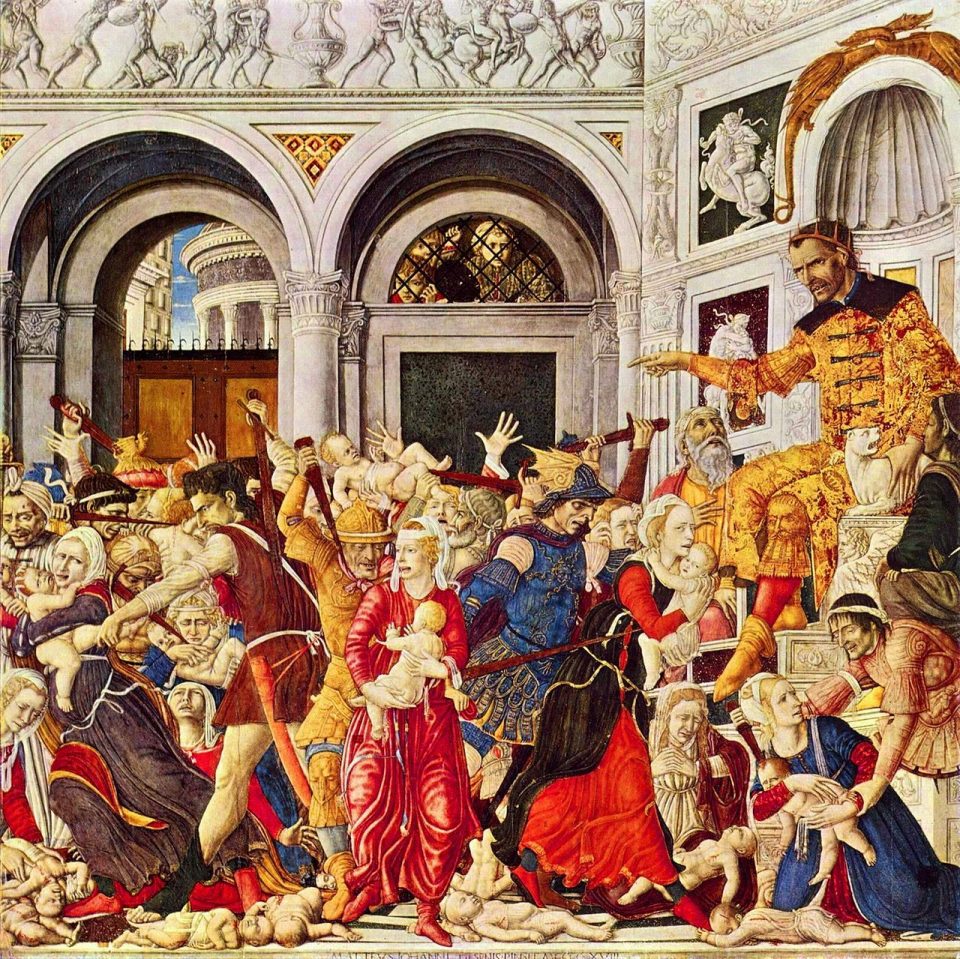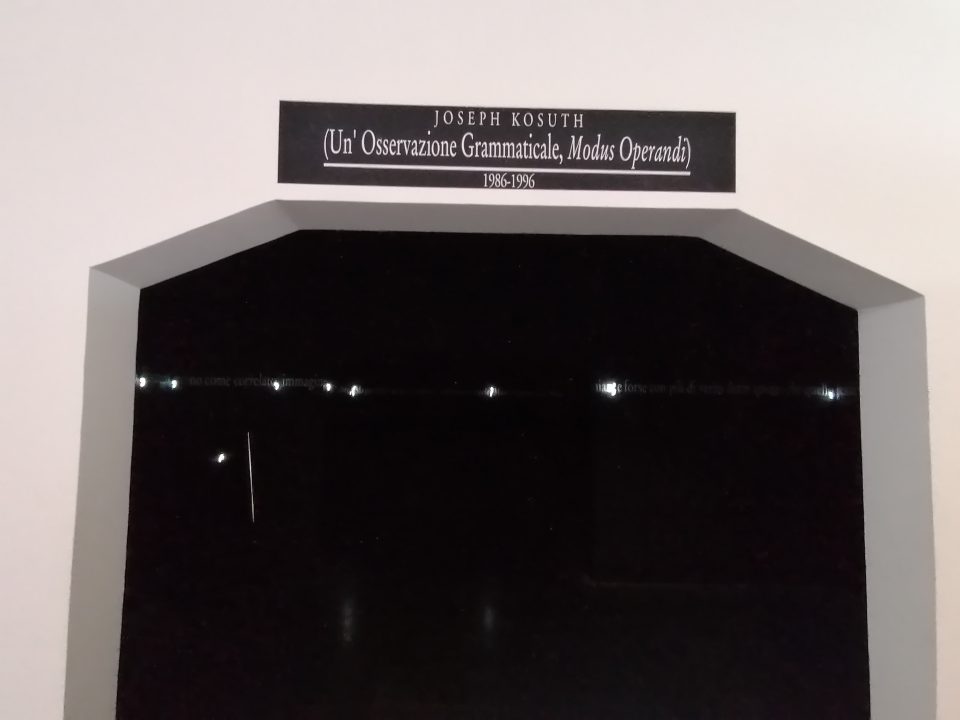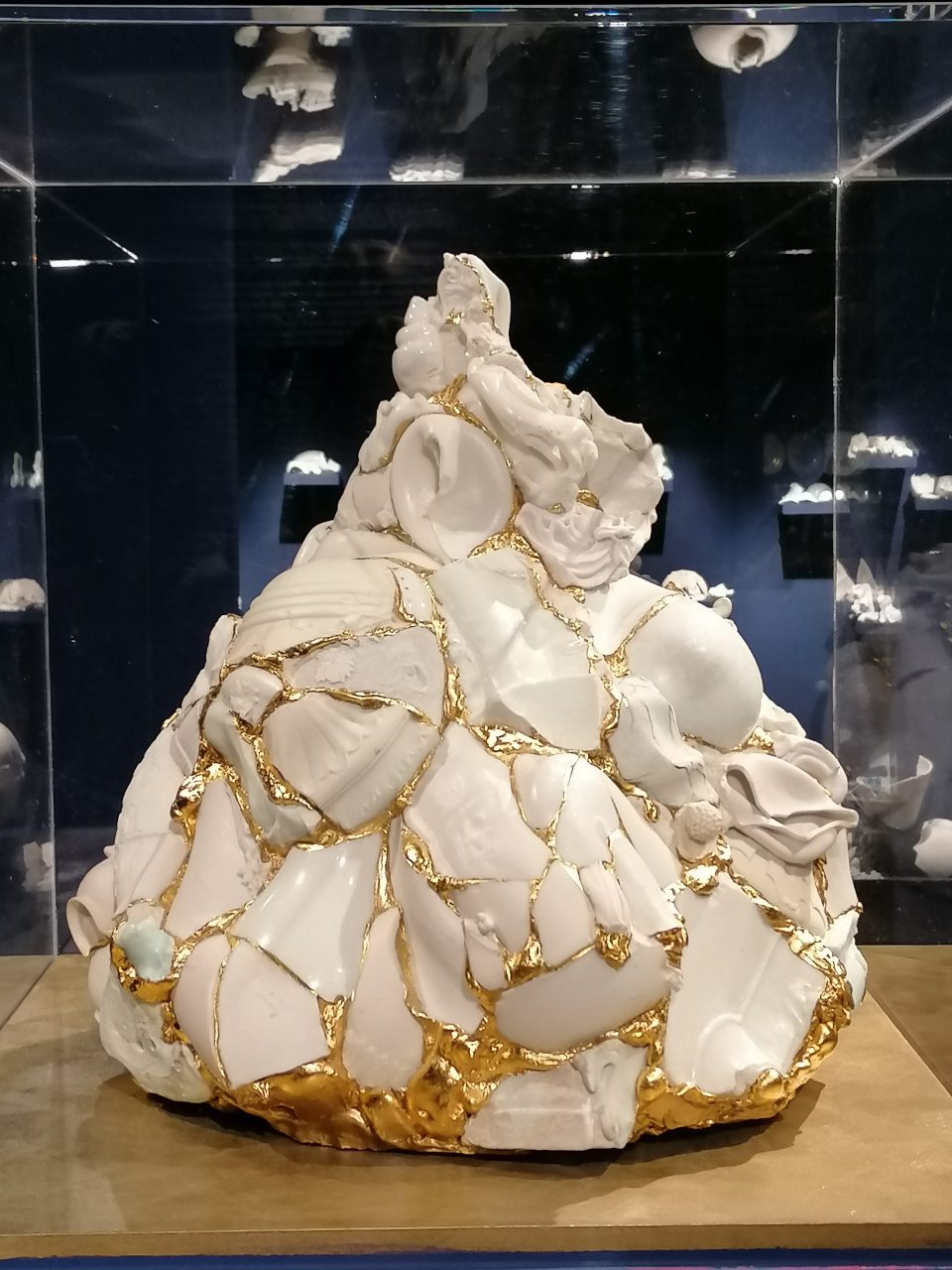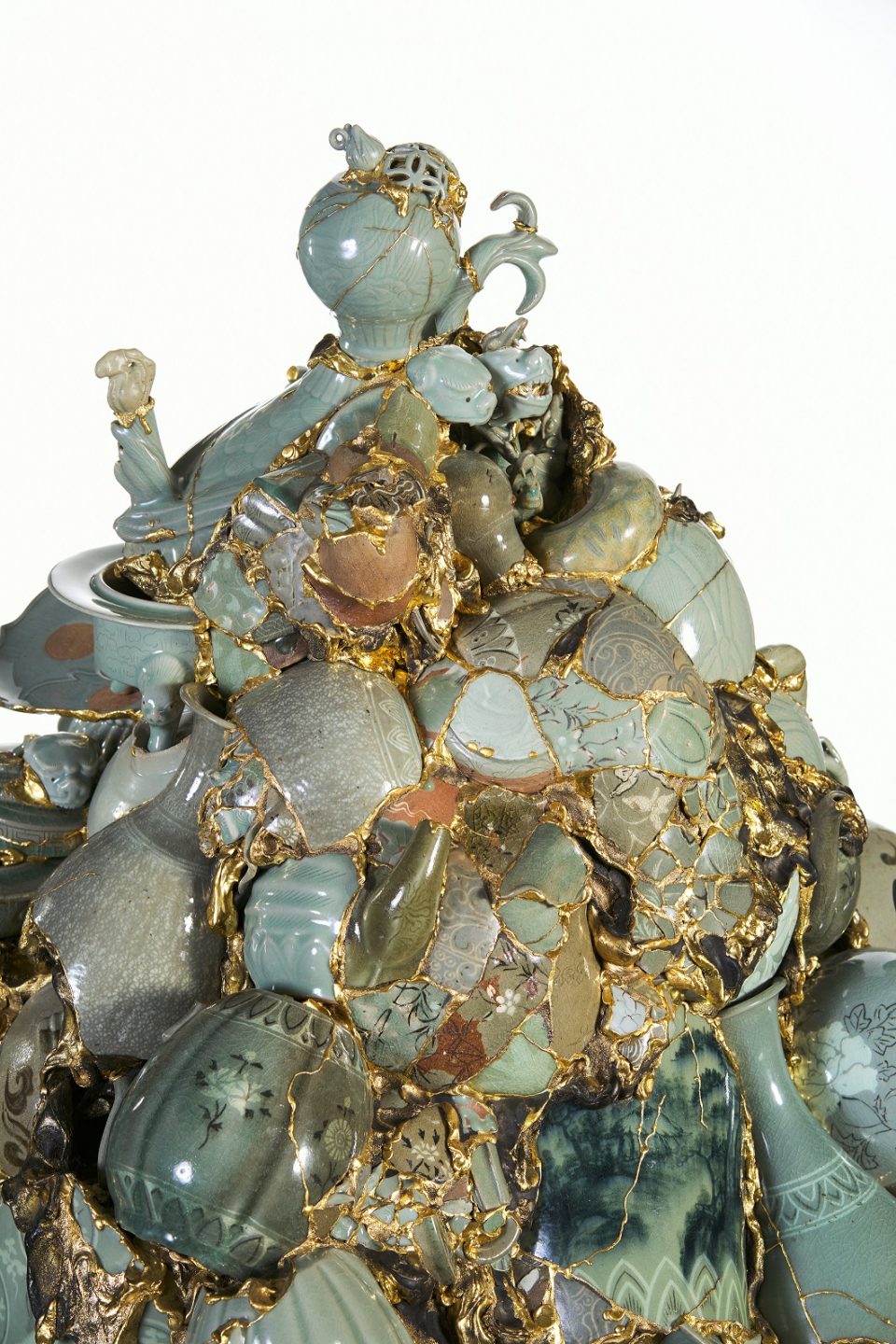Massacre of the Innocents 1488 Matteo Di Giovanni Art
Capodimonte National Museum is one of the largest museums in Italy, meaning you could spend hours if non days observing each and every artwork it houses. Located on the Capodimonte hill overlooking the metropolis of Naples, it was previously the Bourbon family'southward royal palace. It contains an ensemble of different collections, the most important of which are the Farnese and Neapolitan galleries, comprehending paintings by local artists from 1200 to 1700. The museum was established in 1757 following Charles of Bourbon's demand to find a place to store the collection inherited past his female parent Elisabeth Farnese. Over the years, the palace was enlarged and filled with more art until a gallery housing the contemporary section was added in 1996.
Some of the nearly well-known pieces include Caravaggio's Flagellation (1607–1608), Botticelli's Madonna and Child and Two Angels (1470), Masaccio'south Crucifixion (1426), Titian'south Mary Magdalene (1550) and Artemisia Gentileschi's Judith and her Maid Retainer (1645-50). If you happen to be in Naples and you decide to become to the Capodimonte Museum, these are the artworks that are labelled as the about crucial to run into, but what is special about a museum is that information technology can exist a identify of wonder, a identify where y'all want to be surprised by what strikes your attention during your visit. This is the reason why I accept created a option of iv underrated highlights, artworks which you would probably non even notice if you spend your time in this museum walking directly to the most famous artworks.
Our start stop is Massacre of the Innocents, a tempera on console painting by Matteo di Giovanni executed betwixt 1481 and 1488 in the Tuscan city of Siena and commissioned by Alfonso Two of Naples. The scene represented by di Giovanni is the tragic moment in which the Ottomans enter the church of Santa Caterina at Formiello (Naples) and first killing everyone who is inside, predominantly innocent women and their children, generating a massacre. Interestingly, the church is represented with neat particular, including the Ionic uppercase sustaining rib vaults and the reliefs above them depicting battle scenes from antiquity. What caught my attention is the facial expressions. Matteo di Giovanni – looking forwards towards the Renaissance but all the same heavily influenced by the Gothic style – portrays women in a moment of profound suffering, expressing their emotions by screaming, crying or terrifyingly scrutinizing the invaders while the dead bodies of their children are lying on the church building ground. It well-nigh feels like the painting emits sounds due to the intensity of the image in its entirety. This effect is derived from the fact that the artist chooses to place the women and the Ottomans on the foreground at the expense of linear perspective – a characteristic that will afterwards exist key to the Renaissance fashion. This results in a way equally if the characters are coming out of the space towards the states simply at the same time there is no perception of space between the figures, appearing similar a vibrant conglomeration of bodies. The cropped figures on the sides suggest the existence of a larger epitome of which di Giovanni wants u.s.a. to focus exclusively on this section. It resembles neither an idealized Renaissance scene of suffering nor a theatrical Bizarre act; the creative person wanted to highlight how pain distorts faces in different and unidealized ways. Lastly, the rich garments of the Ottoman leader sitting on the marble throne on the correct – thus disproportioned confronted to the other figures below him – are depicted with such item that is possible to spot the gilt ornaments on information technology, including the depiction of a human caput on his left knee.

Our second stop is A Grammatical Remark. Modus Operandi past the American conceptual artist Joseph Kosuth. He is all-time known for combining art, philosophy and linguistic communication resulting in a research focusing on the relation betwixt the object and its definition. Yous have probably heard him before thanks to his famous piece I and Iii Chairs (1965), an installation in which he presents a chair, the moving-picture show of the same chair and the vocabulary definition of a chair, thus questioning which one is the real object associated with the word. A Grammatical Remark. Modus Operandi is a 1980s installation in which the artist writes two quotes from the philosophers Gian Battista Vico and Ludwig Wittgenstein in white on blackness walls, a reference to the definition of art every bit an intellectual reflection and how it is able to shape our thoughts. What caught my attention while entering this night room was the position of neon lights, used past Kosuth to determine the punctuation of the ii quotes. In Vico's quote, it is mentioned the Latin phrase "human being non intelligendo, fit omnia" meaning that our ignorance is the basis of our freedom. Change can have place only when we admit our ignorance because by admitting it we also demonstrate that we acknowledge our mistakes and are open up to learning more. There are also two mirrors placed in two strategic corners of the darkroom, facing the observer while he is reading. 1 mirror is placed under the department of the quote that says "language appears related to the paradigm", pushing the observers to expect in the mirror and stimulating them to remember about the reflection – meaning in this case both the return of the epitome and the deep thinking that these philosophical quotes induce.
-

Credit: Belen De Bacco -

Credit: Belen De Bacco
Our 3rd stop is the polyptych Untitled past the contemporary Italian artist Umberto Manzo. This piece was completed in 2016 and it is made of a mixture of different techniques on paper, canvas, forest, iron and glass. Umberto Manzo studied art at the Accademia di Belle Arti in Naples. From the 1980s he started appearing on the national art scene, greatly developing his personal artistic language. He was one of the artists called to participate in the region's project Stations of Art in which well-known contemporary artists were appointed to design new environments for some of the Naples metro stations equally part of the city's redevelopment projection. Manzo'south well-nigh recent pieces focus on what he calls "annal-works"; the artist creates drawings which are placed overlapped in new frames, resulting in multi-shaped cuts whose silhouettes suggest the borders of classical statuary. What I particularly liked about this artwork is the way Manzo expresses his relation with Naples, the urban center where he was born and where he constitute his creative voice. Within the head of Aphrodite, goddess of beauty and passion, Manzo decides to identify multi-shaped cuts which remind us of the history of Naples as a stratified city where Greek foundations coexist with street fine art, creating a multiple only simultaneously unitary narrative. Untitled represents an interesting combination of the fragility of classical bronze and its tension towards immortality, while also referring to the archive as perishable. It is of import to notice that Manzo's concept of annal is far from existence a conservation container where the information is logically classified, he rather interprets it equally the key to access memory and identity. The artist substitutes the stockpile of data with the irregular layering of retentiveness, an act of revolution towards the perishability of the substance that involves both humans and objects. Hence, his artworks become both the expression of creativity and the document of history.

Our fourth and last stop is Translated Vase Special Edition of Napoli by the South Korean artist Yeesookyuong. It is a piece created in 2019 especially for the Whisper Just to You lot exhibition (2019-2020). It is interesting to observe that this artwork is made by 18th Century porcelain shards which derive direct from the Royal Capodimonte Porcelain Manufacturing plant (established in 1743), which was a key production centre in the Spanish viceroyalty. In 18th-Century Europe it was impossible to be seen as a powerful and influential reign if the manufacturing sector was not developed. Porcelain was also called "white gilt" and European manufacturers looked at Mainland china to better understand this new material. European courts used porcelain objects as gifts for important figures, thus showing off their richness and finesse. Porcelain was therefore considered equally an object which detained political status and technical prowess. Unfortunately, Charles III ordered to establish a new porcelain factory in Madrid and destroyed the one at Capodimonte, thus transferring all the production to Espana as well every bit the all-time craftsmen. Yeesookyuong revives the Capodimonte Factory by masterfully combining porcelain fragments with plaster, polystyrene, epoxy and 24k gold leaf added in the fractures of the composition to create a sculpture which evokes a reinterpretation of an 18th-Century tradition in a contemporary setting. The concept of an artwork generated from waste is particularly intriguing, reusing material in order to create something new just withal continued to tradition, teaching u.s. that history is never a continuous line but rather an aggregating of imperfection and fragility. Yeesookyuong'south Translated Vase serial launched the artist in the international art scene, who is peculiarly acclaimed for her versatility in different mediums comprising painting, sculpture, video, operation and installations. Her fashion of uniting Eastward and W in her sculptures is proved by her employ of European porcelain and the Korean manner during the Goryeo (918–1392) and Joseon (1392–1897) dynasties.
-

Credit: Belen De Bacco -

Credit: Yang Ian
From 13th Century to Contemporary art, from Egyptian-style clocks to tapestries, the Capodimonte National Museum is rich in its diversity of artworks, aiming to accept simultaneously a national and international vision by including sections on Neapolitan and international artists, as the presence of Yeesookyuong'south artworks proofs. The Capodimonte Museum teaches united states that visiting art museums has to become a way of educating how to wait. The highlights of the museums and the most famous masterpieces are always pointed out by the museum maps but it is of import to encourage to have a wider look at what is around you rather than simply stopping at the artworks you know. It has to be reminded that the company is the 1 who has the power to decide which artworks to stop by and how much fourth dimension to spend experiencing them. We are all different people with dissimilar tastes and we as well react in unlike ways to artworks, both intellectually and emotionally. The museum experience is highly subjective and depends upon what every unmarried one of united states of america puts into it. Museums are places for anybody, not just élite intellectuals or art history students. Everyone can enjoy a museum visit and larn from information technology. It is a cultural middle that reunites dissimilar thoughts and ways of expression.
The next temporary exhibition at the Capodimonte National Museum will be Gemito. From sculpture to drawing and volition run from tenth September to 15th Nov 2020, comprising 19th-Century artworks of the Neapolitan creative person Gemito. Afterward the great success of this afoot exhibition in Paris, it will finally go far in the creative person'due south birth urban center.
http://www.museocapodimonte.beniculturali.information technology/portfolio_page/prossime_mostre/
Source: https://artgateblog.altervista.org/4-underrated-highlights-of-the-capodimonte-national-museum/